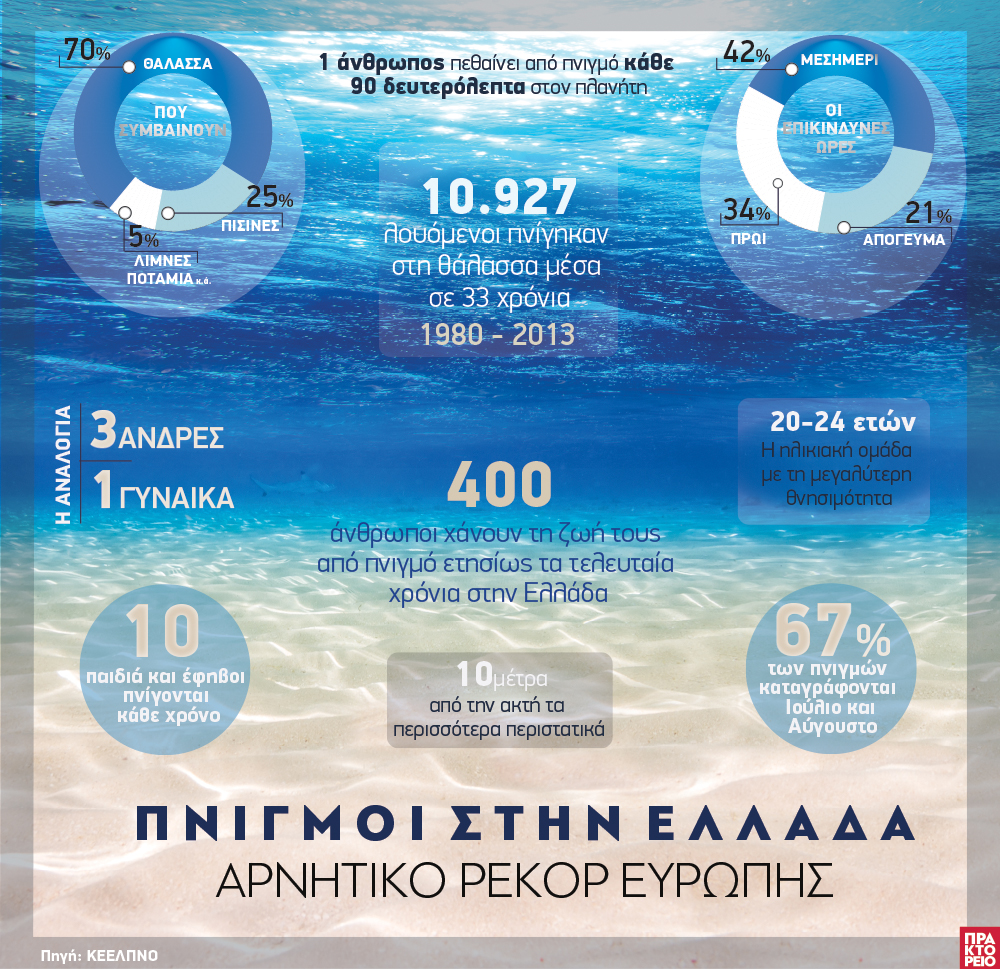Drowning
Annually more than 400 people drown in Greece. From the beginning of the season until August this year about 2 people per day drowned.
According to some statistics, these are mostly men between the age of 20 and 24, and in risk groups there are children up to 5 years and elderly.
On our planet, every 90 seconds one person drowns.
What I wanted to share with you is one very useful text written by Mario Vittone, maritime safety expert and long-time lifeguard.
Drowning does not look like drowning
The lifeguard climbed onto his ship, and suddenly completely dressed jumped into the water. He was swimming with all his strength to the couple that was having fun in the water between the anchored ship and the beach.
“Probably this man who swims towards us thinks you’re drowning,” said the husband to his wife.
They were having fun in the water and started shouting loudly. “Is something wrong? What is he doing?”
During that time, he was shouting something to them.
The savior did not care about the two of them and continued to swim with all his might.
“Get out!” he screamed as he dived towards them.
“Why?”
Immediately behind them, about five meters away, their nine-year-old daughter was drowning.
The saviour was swimming towards her and saved her.
The girl immediately caught him and shouted in tears: “Daddy!”
How did the former lifeguard noticed from a distance of 20 meters what the father did not notice from less than 3m?
Drowning is not dramatic, as most people think. Based on the knowledge and many years of experience, the lifeguard recognized drowning. The father, like every ordinary layman, thinks that drowning looks like on television shows.
If you spend time at sea, it’s good to know the signs that indicate drowning. Until she cried “Daddy!” (When she was already secure), the girl was drowning in complete silence.
As a former lifeguard, I was not surprised by this story. Drowning is mostly silent event.
Waving hands, clapping on water and screaming are only present in movies, and not in real life.
The natural response of the organism to drowning is to prevent screaming and casting voices during drowning.
Therefore, drowning is usually not dramatic as shown on television. When a person drowns, there are very few or no signs.
To make it easier to imagine how quiet the drowning is, read this fact: drowning is the second most common cause of death for children up to 15 years (immediately after a car accident). Of the 750 children who drown each year, about 375 are drowned in the immediate vicinity of their parents or adults. In 10 percent of cases, adults will even watch drowning and will not recognize it on time.
The drowning does not in any way seems as drowning, and dr. Pia (who wrote the definition of the body’s natural response to drowning) described how the body responds to drowning.
Except in extremely rare cases, people can not call for help due to psychological causes of drowning. The breathing system is just for breathing. Speech is secondary. Breathing must be provided to be able to speak. During drowning, mouth of the person is for some time in the water and for some time in the air. In the meantime, there is not enough time on the surface for person to catch the air, exhale and scream at the same time. When drowning, you can not point out that you are in trouble. A natural instinct forces your hands to put pressure on the surface of the water to climb over it. The psychological response of the body to drowning is such that a person can not bend to help himself or to give his hand to the lifeguards or rescue equipment. From the beginning to the end, the natural response of the organism to drowning does not allow controlled movements. For this reason, the person who drowns does not show signs of the so-called struggle for life.
If a drowning person does not get the help quickly, the body can fight around 20 to 60 seconds before drowning (Source: On Scene magazine: Autumn 2006, page 14).
Of course, all the above does not mean that the person screaming for help is not in great trouble. It can also happen that the natural response of an organism to drowning is not so strong, so a person helps his own salvation.
What symptoms show that a person is drowning?
- That the whole head is in the water or just the mouth.
- The head is turned back with the mouth open.
- The eyes look “glassy” and empty - the person can not sharpen the image.
- The eyes are closed.
- The hair covers the forehead or eyes.
- The person does not use his legs.
- Hyperventilation or panic capture/swallowing of the air.
- Trying to swim in a certain direction, but without success.
- The person is trying to turn on his back.
So, how can you make sure that the person is alright?
If you simply ask: “Are you okay?”
If the person answers, it’s probably okay.
When it looks unconscious and does not answer, you have 30 seconds to save it.
First of all, PARENTS - PAY ATTENTION TO THIS: children playing in the water are loud.
As soon as you cannot hear them, check the silence.
Follow us on social media and stay up to date with everything you are interested in about Greece!
Facebook:Nikana.gr
Instagram: @nikana.gr
Tiktok: nikana.gr
Facebook group: Live from Greece
YouTube kanal @NikanaTravel
Send us your question by mail to: nikana@nikana.gr







Post a Comment
NOTE
All your questions in the comments will receive an answer via email so check your inbox shortly after you posted comment. For more detailed questions and responses, contact us via mail nikana@nikana.gr.